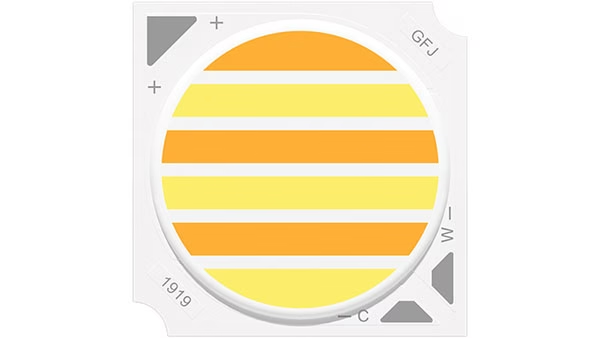Comparison Between Dual-Color Temperature COB LEDs and Traditional Monochromatic COB LEDs in Recessed Downlights

Table of Contents
COB (Chip-On-Board) LED technology is widely used in recessed downlights for its high efficiency, compact design, and uniform light distribution. The market offers a variety of COB LED options, including traditional monochromatic COB LEDs and dual-color temperature COB LEDs. This article compares these two types of COB LEDs, focusing on their wiring configurations, control mechanisms, and typical applications in recessed downlight systems.
Definition and Basic Functionality
Traditional Monochromatic COB LEDs:
Traditional COB LEDs, such as the Cree 1304, 1507, or 1816 models, emit light at a fixed color temperature (e.g., warm white or cool white). These LEDs feature a simple design with two connection points: one for the positive terminal and one for the negative terminal. The two-wire setup allows for easy connection to a power supply, making installation quick and straightforward. These LEDs provide consistent light at a fixed color temperature, ideal for environments where color temperature does not need to change.
Dual-Color Temperature COB LEDs:
In contrast, dual-color temperature COB LEDs are designed to offer two selectable color temperatures (typically warm white and cool white) from a single chip. These LEDs feature one positive terminal and two negative terminals, each controlling one of the two color channels (warm white and cool white). By adjusting the current supplied to the negative terminals, the LED can produce a mix of warm and cool light, providing flexibility to change the color temperature as needed. This type of COB LED is ideal for environments where adjustable lighting is required.
Wiring and Installation Differences
Wiring for Traditional COB LEDs:
Traditional monochromatic COB LEDs use a simple two-wire configuration, with one wire for the positive terminal and one for the negative terminal. This straightforward design makes them easy to install in recessed downlight fixtures, as they can be directly connected to the power supply. These LEDs do not require any additional components, making them ideal for environments where fixed lighting is sufficient.
Wiring for Dual-Color Temperature COB LEDs:
Dual-color temperature COB LEDs, however, require a more complex wiring setup. These LEDs have three terminals: one for the positive connection and two for the negative connections. The two negative terminals are used to control the two color channels—warm white and cool white. A controller adjusts the current supplied to each of the negative terminals to mix the warm and cool light, allowing the user to switch between or combine the two color temperatures. This setup provides more flexibility but requires additional wiring and a controller for operation.
Applications and Benefits
Traditional COB LEDs:
Traditional monochromatic COB LEDs are best for applications where a fixed light color is desired. They are commonly used in:
- General lighting for homes, offices, and commercial spaces
- Residential settings (e.g., living rooms, kitchens, hallways) where consistent color temperature is preferred
- Outdoor lighting, where a steady and unchanging light is needed
Dual-Color Temperature COB LEDs:
Dual-color temperature COB LEDs are ideal for spaces where lighting needs to be adaptable. These LEDs are particularly useful in:
- Smart homes and offices, where changing the color temperature can improve mood, productivity, and comfort
- Healthcare environments, where mimicking natural light helps regulate circadian rhythms
- Retail and hospitality, where adjustable lighting can highlight products or create different atmospheres
- Residential spaces, where the color temperature can be adjusted for various activities (e.g., warm light for relaxation, cool light for tasks)
Cost and Complexity
Traditional COB LEDs:
Traditional monochromatic COB LEDs are more affordable due to their simple design. They are easy to install and mass-produce, making them a cost-effective choice for environments where color temperature adjustments are not necessary. The simplicity of the wiring and the lack of a need for additional controllers make them an attractive option for budget-conscious users.
Dual-Color Temperature COB LEDs:
Dual-color temperature COB LEDs are more expensive, mainly due to the additional complexity in wiring and the need for a controller to manage the color temperature. While these LEDs provide more flexibility, they come with higher installation and component costs. However, their versatility in adjusting lighting conditions can make them a worthwhile investment for spaces that require dynamic lighting.
Final Thoughts
In recessed downlight applications, traditional monochromatic COB LEDs are a reliable and affordable solution for environments that require fixed lighting. They are easy to install and operate, with minimal setup required.
Dual-color temperature COB LEDs, on the other hand, provide the flexibility to adjust the color temperature, making them ideal for dynamic lighting environments. While they are more complex and expensive to install, their ability to change lighting conditions based on user preferences or time of day offers significant advantages in spaces where adaptable lighting is needed. The choice between the two ultimately depends on the specific needs of the space, budget, and desired lighting control.
Traditional COB LEDs are a simpler, cost-effective choice for fixed lighting needs, perfect for residential or straightforward commercial applications. The decision depends on budget and desired lighting control.

